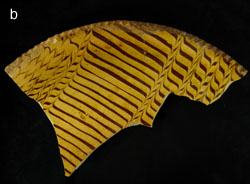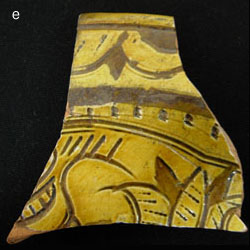Slipware

Don't let the past slip away.
2007's Archaeology Month theme, "Don't let the past slip away," is an archaeological pun. While we are true to the obvious meaning, slip is also a material used to decorate the ceramics featured. Slipware, as some archaeologists call it, is made by trailing a slip—or heavily diluted colored clay—onto a vessel before it is fired. These slips were applied in a variety of decorative techniques.
The most basic slipware design is known as “slip trailing” (a, d). The potter applied lines or dots of slip onto a vessel using a tool called a slip cup. Most slip cups were simple containers made of clay with a reed or quill nozzle.
To create “combed slipware” (b) the potter started by pouring one color of slip over the entire surface of the vessel. Immediately after this first coating, a slip of contrasting color was applied from a slip cup in parallel lines over the surface. Then a sharp tool, usually made of animal bristle, was pulled through these lines creating a zigzag effect. Example c shows how combed and trailed techniques can be combined to create more elaborate patterns.
“Marbled slipware” (not shown) is similar to combed slipware because it uses two different colors of slip. All of the steps were the same up until the very last one. Instead of using a comb to mix the colors, the potter tipped and rotated the vessel so that the slips would swirl around each other, creating a “marbled” appearance.
The earliest British slipware that archaeologists find in New England is “sgraffito” (e) A slip (a different color from the clay body) was poured all over the vessel. When it had dried a little, a tool was used to scrape away the slip and reveal the clay body in whatever designs the artist desired, often floral or geometric forms. Then the entire vessel was glazed, and the two contrasting colors were revealed.




